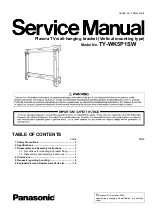
45
Power Supply STR-S6708
(1) V
IN
terminal, start-up circuit
Astart-up circuit is to start and stop a operation of a control IC by detectiong a voltage appearing at a V
IN
terminal
(pin-9). At start up of a power supply, when a voltage at the Vin terminal reaches to 8V (typical) by charging up
C6 by the function of a start-up resistor, Rs, a control circuit starts operating by the function of the start-up circuit.
(2) Oscillator, F/B terminal voltage (pin#7)
A oscillator generates pulse signals which turns a power transistor on and off by making use of charge. and
discharge of C1 and C2 incorporated in the Hybrid IC. (refer to the block diagram of page 30)
Constant voltage control of a switch mode power supply is performed by changing both ON-time and OFF-time
except when the load is light (ex. remote control stand-by mode of TVs).
When the power transistor is on C2 is charged to the set voltage (approx. 2.3V at Ta = 25˚C). ON the other hand, C1
starts charging up through R1 from almost 0V and the voltage across C1 increases in accordance with the inclination
determined by the product of C1 and R1. When the voltae across C1 reaches approx. 0.75V (Tc = 25˚C), the output
from the oscillator is reversed and the power transistor turns off. At the same time C1 is quickly discharged by the
function of a internal circuit of the oscillator and the voltage across it decreases to almost 0V. When the power
transistor turns off, C2 starts discharging through R2 and the voltage across C2 decreases in accordance with the
inclination determined by the product of C2 and R2. When the voltage across C2 decreases to about 1V, the output
from the oscillator is reversed again and the transistor continues turning on ad off by repeating the above mentioned
operations.
The ON-time determined by the above C1 and R1, and the OFF-time determined by C2 and R2 shall be respectively
the maximum ON-time and maximum OFF-time of the power transistor. R1 and R2 are fixed at specific values by in-
line functional trimming.
The ON-time is controlled by changing a charge current of C1, which is as the result of that a photo coupler
connected to the F/B terminal (Pin #7) has the current in accordance with a output signal from a output voltage
detection circuit (an error amplifier) provided in the secondary output flows to the terminal. As an AC input voltage to
the power supply gets the higher and a load current the smaller, the current flowing to the F/B terminal gets the larger,
and the ON-time gets the shorter.
(3) Function of INH terminal (Pin #8), control of OFF-time
Signal to the INH terminal is used as inputs to COMP.1 and COMP.2 inside of the control IC. A threshold voltage of
COMP.1, V
TH
1
is set at 0.75V (Ta=25˚C) and an input signal to a drive circuit becomes almost 0V (the power transistor
is in OFF mode) when a voltage at the INH terminal reaches the V
TH
1
. As long as the INH terminal voltage does not get
lower than V
TH
1
, the power transistor sustains OFF mode. On the other hand, a threshold voltage of COMP.2, V
TH
2
is
set at 1.5V (Ta=25˚C). When the INH terminal voltage reaches V
TH
2
an output from COMP.2 reverses and, as a result,
C2 starts firing and a voltage across C2 drops to almost 0V in a moment. As the result of this immediate discharge of
C2, the OFF-time of the oscillator which has been determined by the product of C2 and R2(
55µsec) can be quicker
up to approx. 2µsec. As long as the INH terminal voltage does not get lower than V
TH
2,
a voltage across C2 stays at
almost 0V and a output from the oscillator keeps the power transistor being OFF.
(4) Quasi-resonant operation
By inputting a voltage signal which is synchronized with the energy discharge time of a secondary winding of a
transformer to the INH terminal, quasi-resonant operation can be achieved.
Summary of Contents for DTR-14D3VG
Page 5: ...3 Circuit Block Diagram...
Page 10: ...8 3 Block Diagram...
Page 66: ...64 1 14D3 Mechanical Exploded View...
Page 67: ...65 2 20D3...
Page 68: ...66 3 21D3...
Page 69: ...67 4 16D3...
Page 70: ...67 Printed Circuit Boards...
Page 71: ...Circuit Schematics CP 490 SCHEMATIC DIAGRAM...
Page 72: ...ENGINEER NOTE...
















































